Why is nutrition info so confusing? Are whole grains healthy or will they give me diabetes? Can I only absorb enough nutrients from animal products? Should I be worried about carbs, fat, or sugar? Today I’m simplifying nutrition for you big time, and sharing the six healthiest foods I eat daily, that you could too.
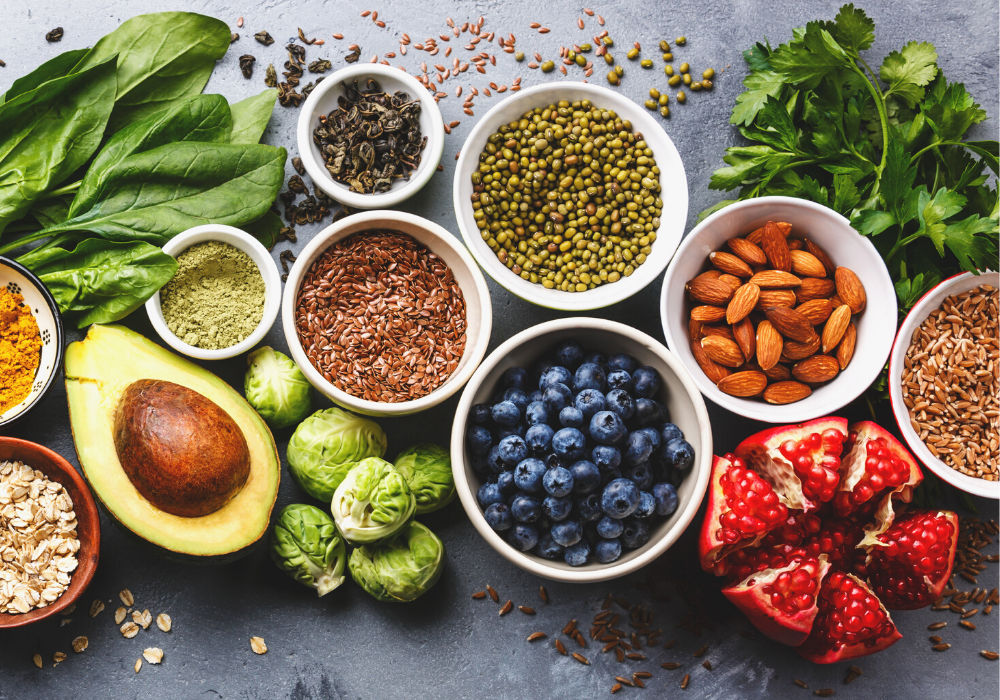
Why? Because tell me this: Are you confused about which foods are healthy and which ones aren’t? Yeah, I thought so. You’re not alone!
The majority of us are confused about basic health and nutrition because there’s so much conflicting info out there. We’re bombarded daily with opposing views on basic nutrition, which means that most people end up with no idea what they should be eating on a daily basis.
And it’s no wonder there’s so much confusion. Media relies on changing consumer interests and being able to generate new, exciting, and shocking headlines for the sake of profits.
Sticking to the same story over and over, especially one that’s been around for decades, isn’t a viable business option for selling constant information to consumers.
If you get past the headlines and social media “experts”, though, you’ll find a place where the consensus is pretty clear and has been for not just years, but decades. That place I’m talking about is science.
By looking at what the science tells us, we can break through the cloud of confusion and get clear on what we should actually be eating for optimum health. And the best part is, it’s surprisingly simple and incredibly refreshing! Shifting from contradicting info and confusion to a clear consensus that lays out the healthiest pathway for each of us, feels like a full 180 about-face, and I’m not complaining. Talk about a breath of fresh air!
It’s really not that complicated.
We sometimes think of nutrition as this big complicated subject that only the specially educated few can understand. And while there ARE complicated systems and processes whenever human bodies are involved, (heyyy fellow complicated living organism 👊🏻), figuring out the big picture of what you should be eating really isn’t that complicated.
Since doing my nutrition studies last year, I now focus on eating lots of whole plant foods and making them the majority of my diet. Why? Because science clearly shows us time and again that the healthiest diet is one that emphasizes whole plant foods and makes them 90% or more of our diets.
You might be used to thinking about nutrition and health from a nutrients perspective because that’s the language the FDA uses. Things like “carbs are bad for you” or “low-fat diet” probably sound commonplace to you. But we don’t actually eat nutrients, we eat FOOD. So while understanding macro and micronutrients can be helpful, the real power lies in the simplicity of whole plant foods. These foods are a package deal with lots of different nutrients already combined for us in optimal amounts. By simply eating a diverse diet filled with a wide range of whole plant foods, we can ensure that we’re not only getting all the nutrients we need but also enjoying ourselves in the process. Ready to eliminate overwhelm and confusion?
Thinking about your diet in terms of whole plant foods and focusing on eating from all the different food groups each day is an easy, big picture way to think about your health and what to eat. Trust me, it’ll make your life so much simpler!
The six healthiest foods I eat daily
While all whole plant foods offer amazing health benefits, there are certain groups that stand out from the rest, and deserve special attention. Specifically, here are the six healthiest foods (actually food groups) I make a point of eating every single day.
- Whole grains (and whole grain products)
- Legumes (beans & lentils and legume products)
- Berries (mostly frozen in smoothies but also fresh when they’re in season)
- Nuts and seeds (especially flax seeds, hemp seeds, chia seeds, and walnuts)
- Green veggies (leafy greens & fresh herbs)
- Herbs & spices
Eating from these six food groups daily ensures I easily cover all my nutrition requirements without the need to count calories, track my nutrient intake, or worry about staying healthy. (There are a few additional things, like iodized salt, that I also include on a regular basis. Click here and scroll to the bottom to learn about all my daily nutrition targets and get your own Daily Health Targets checklist.)
The health benefits of these foods
You might be wondering why I choose these specific foods every day over others. Keep reading to learn why, and let’s break this down a little.
Whole Grains
Whole grains, whole grain products, and starchy root veggies like potatoes and sweet potatoes form the basis of most indigenous cultures’ diets. These foods have fueled us for centuries and there’s a good reason for that. Our cells thrive on carbs, not refined white flour products or sugary sweets but complex carbs from whole plant foods.
Whole grains contain:
- A lot of fiber, and these are different types of fibers than those found in veggies and legumes, (yes, there are different types of fiber!) so it’s important to get the full fiber spectrum
- Lots of B vitamins
- Trace minerals like iron, zinc, copper, and magnesium
Research studies also show that eating whole grains daily is associated with a lowered risk of heart disease, type 2 diabetes, and even some forms of cancer. Pretty compelling reasons to eat whole grains, right?
Legumes
This is a huge family of foods that includes everything from chickpeas to red lentils to butter beans and everything in between.
Legumes are a WONDERFUL source of plant-based protein. They’re also loaded with the all-important fiber, iron, zinc, and b vitamins. And that’s just a snippet of their nutrient profile.
In addition to beans and lentils being a super easy and delicious way to bulk up any meal, one of the main health reasons to eat legumes daily is because of their astounding cancer-fighting benefits. Top cancer researchers in the world share a common recommendation to include 1-1½ cups of beans or lentils daily for maximum cancer-fighting benefits.
Berries
Although all fruits are healthy and deserve a place in your diet, berries deserve special attention because they’re one of the healthiest foods we can eat. Not only are they super high in fiber, but they’re also loaded with antioxidants, which are at least partially responsible for the protective effects berries have against cancer and heart disease. Berries also offer a boost to the immune system (thanks to all those antioxidants) and can help reduce the risk of type two diabetes.
Who knew such a delicious food had such amazing health benefits?
Nuts & Seeds
Nuts and seeds are nature’s fat sources and serve as the best whole food sources of fat available to us.
Healthy fat in our diets is super important for so many bodily functions including healthy hormone production and brain development, so I make a point of eating some nuts and seeds every day. I especially like to include omega-3 rich nuts and seeds like ground flaxseeds, chia seeds, hemp seeds, and walnuts in my meals.
Leafy Greens
If berries are the healthiest fruits, then greens are by far the healthiest veggie. So while all veggies are amazing for our health, leafy greens, in particular, boast massive nutrients in their fragile leaves. In fact, greens might be the healthiest food on the planet. While it is hard to put a single food at the top as “healthiest,” greens are definitely in the top two.
Don’t believe me? A team of Harvard researchers analyzed a bunch of different food groups, and greens turned out to be associated with the strongest protection against major chronic diseases. What this means for us on a daily basis is that eating greens nearly every day may be one of the most powerful steps you can take to prolong your life. I’m super into prolonging my life, how about you?
Herbs & spices
I mentioned berries as being an antioxidant superpower, but it’s actually herbs and spices that take the cake for having the most antioxidants of any food group. Antioxidants protect us against disease by boosting our immune systems. Adding just sprinkles of herbs or spices into your meals makes a huge difference to antioxidant levels in your body. In addition, adding spices into your meals, in particular, helps boost your digestion by bringing heat into your digestive system. (Just think about the last time you ate Indian food and then needed to go to the bathroom immediately after, that’s those spices talking.)
Each one of these six food groups has powerful health benefits, which is why I choose to include them in my diet every day. This is such powerful information because it puts our own health back in our hands by giving us the knowledge and opportunity to choose which foods to prioritize.
How I include these foods in my meals daily
So now you know just how healthy these six food groups are, and why I eat all them daily, but you might be wondering how I manage to incorporate all these foods into my diet in a single day. I know it might seem like a lot, but don’t get overwhelmed just yet! It’s actually easier than you might think and I’m going to show you exactly how I do it.
Let’s start with the most important meal of the day, shall we?
Breakfast
For breakfast, I have a bowl of steel-cut oats with a generous dollop of natural peanut butter, whatever berries are in season (or stewed frozen berries when none are in season), some other type of cut-up fruit, a sprinkle of walnuts, hemp seeds, and cacao nibs, and soymilk.
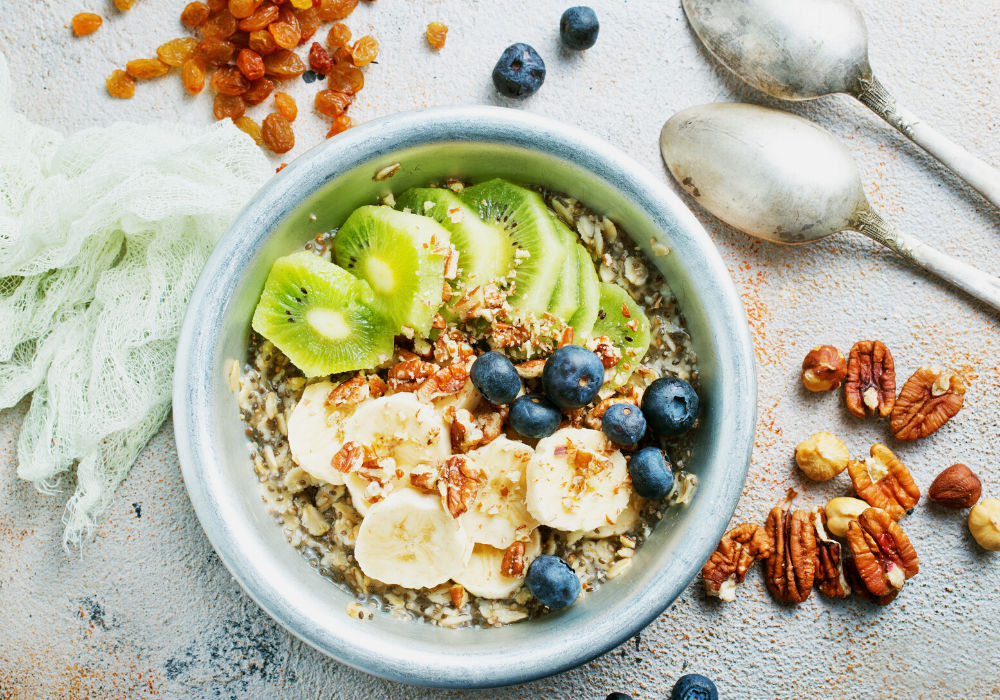
If we look at our six food groups, in this meal alone I’m eating whole grains, berries, nuts, and seeds. If you wanted to boost the nutritional value of this meal even more, you could add a sprinkle of cinnamon, nutmeg, and cardamom for a cozy autumnal breakfast.
AM Snack
Mid-morning I often make a smoothie. The specific flavor and color tend to vary with my mood and what I have on hand, but it almost always includes frozen berries, a ripe banana, a spoonful of nut butter, a handful of baby greens, some ground flax seeds, soymilk, and water.
This mini-meal helps keep me full until lunchtime and gives me extra servings of berries, omega-3-rich seeds, and greens. (If you’re interested in trying this type of smoothie yourself, click here to get my Very Berry Smoothie recipe.)
Lunchtime!
Unlike my breakfast, which stays pretty much the same every day, my lunches vary all the time. I’ll often have some sort of hummus+roasted veggie+grain bowl though, because it’s easy to throw together, can be changed depending on the type of cuisine I’m craving that day, and always tastes delicious. (By the way, I share how you can make this meal and why it’s such a good lunch in detail here. Check it out to learn more!) Hummus is such an easy and delicious way to add legumes to your diet. I love to make my own because the varieties are endless, but store-bought works well too. I also try to include a simple leafy green salad on the side of whatever lunch I’m eating.
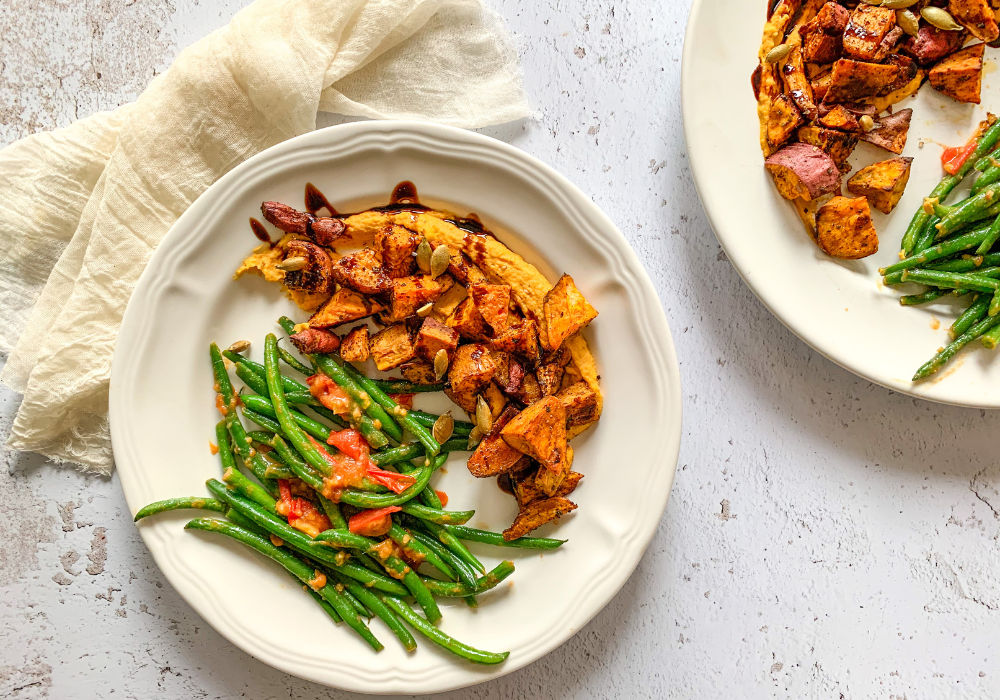
In this type of meal I’m getting those important legumes, greens, whole grains, plus a bunch of spices I add to the roast veggies, and seeds in the form of tahini in the hummus.
Time for Dinner
Finally, for dinner, my go-to is some sort of curry or stew over whole grains. It’s warming and filling, and I love one-pot meals in bowls. Another one of my favorites is a hearty pasta dish like a cashew-based mac and cheese. (Click here to get the recipe for my Healthy Loaded Mac & Cheese, which is truly one of my favorite meals of all time and ticks off five of the six food groups in just this one meal!)
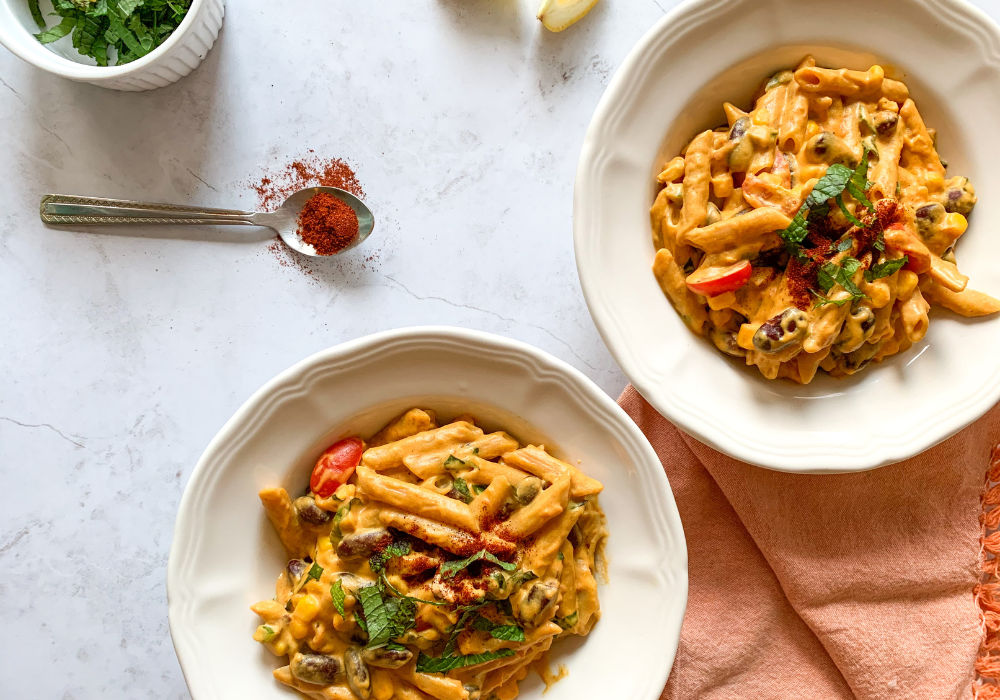
And there you have it, a full day of eating that easily covers all of the six healthiest foods, several times over! That’s just a sample of what one day of eating for me looks like, but hopefully seeing all this is helping you feel more confident about including these six food groups in your daily diet as well.
If you’ve been in this community for a while, you’ll know that the nutrition advice I give is guided by science. I’m not one for individual anecdotes and try to keep things clear and simple based on what research tells us is true. That being said, I know it can be difficult to distill scientific findings down into actionable information that helps you figure out what to eat every day, which is why I wrote this blog post. I hope it helps give you an idea of what a whole food plant-based diet might look like and how you can easily incorporate these six food groups into your diet without overwhelm or confusion.
Now it’s your turn: what are the six healthiest foods YOU eat every day and why?
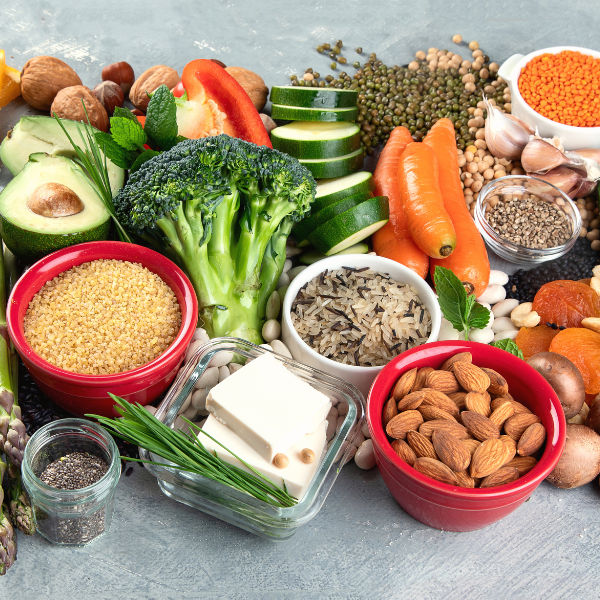
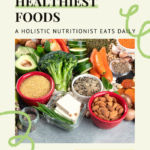
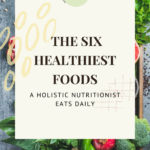
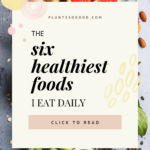
Leave a Reply